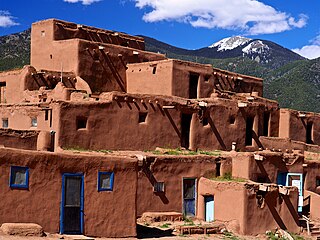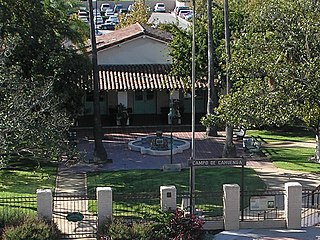Archeological Site No. LA 54021 | |
| Nearest city | Animas, New Mexico |
|---|---|
| Area | 3.8 acres (1.5 ha) |
| MPS | Animas Phase Sites in Hidalgo County MPS |
| NRHP reference No. | 92001802 [1] |
| NMSRCP No. | 1314 |
| Significant dates | |
| Added to NRHP | January 23, 1993 |
| Designated NMSRCP | October 24, 1986 |
Archeological Site No. LA 54021 is a prehistoric archaeological site in Hidalgo County, New Mexico. The site dates from the Animas phase, which spanned from 1200-1350 A.D. Adobe structures with at least 16 total rooms have been found at the site; these structures may represent a transitional phase between pit dwellings and larger Animas compounds. Six of these rooms are filled in with soil and retain their cobble foundations and parts of their adobe walls. The site also includes ceramic remains and some stone artifacts. [2]
The site was added to the National Register of Historic Places on January 23, 1993. [1]

Taos Pueblo is an ancient pueblo belonging to a Taos-speaking (Tiwa) Native American tribe of Puebloan people. It lies about 1 mile (1.6 km) north of the modern city of Taos, New Mexico. The pueblos are one of the oldest continuously inhabited communities in the United States. This has been designated a UNESCO World Heritage Site.

Casa Grande Ruins National Monument, in Coolidge, Arizona, just north-east of the city of Casa Grande, preserves a group of Hohokam structures dating to the Classic Period (1150–1450 CE).

Bent's Old Fort is an 1833 fort located in Otero County in southeastern Colorado, United States. A company owned by Charles Bent and William Bent and Ceran St. Vrain built the fort to trade with Southern Cheyenne and Arapaho Plains Indians and trappers for buffalo robes. For much of its 16-year history, the fort was the only major white American permanent settlement on the Santa Fe Trail between Missouri and the Mexican settlements. It was destroyed in 1849.

El Presidio Real de Santa Bárbara, also known as the Royal Presidio of Santa Barbara, is a former military installation in Santa Barbara, California, United States. The presidio was built by Spain in 1782, with the mission of defending the Second Military District in California. In modern times, the Presidio serves as a significant tourist attraction, museum and an active archaeological site as part of El Presidio de Santa Barbara State Historic Park.

The Campo de Cahuenga, near the historic Cahuenga Pass in present-day Studio City, California, was an adobe ranch house on the Rancho Cahuenga where the Treaty of Cahuenga was signed between Lieutenant Colonel John C. Frémont and General Andrés Pico in 1847, ending hostilities in California between Mexico and the United States. The subsequent Treaty of Guadalupe Hidalgo of 1848, ceding California, parts of Colorado, Nevada, New Mexico, and Arizona to the United States, formally ended the Mexican–American War. From 1858 to 1861 the Campo de Cahuenga became a Butterfield Stage Station.

There are more than 1,500 properties and historic districts in the U.S. State of Colorado listed on the National Register of Historic Places. They are distributed over 63 of Colorado's 64 counties; only the City and County of Broomfield currently has none.

Rancho Petaluma Adobe is a historic ranch house in Sonoma County, California. It was built from adobe bricks in 1836 by order of Mariano Guadalupe Vallejo. It was the largest privately owned adobe structure built in California and is the largest example of the Monterey Colonial style of architecture in the United States. A section of the former ranch has been preserved by the Petaluma Adobe State Historic Park and it is both a California Historic Landmark and a National Historic Landmark. The Rancho Petaluma Adobe State Historic Park is located on Adobe Road on the east side of the present-day town of Petaluma, California.

The Sánchez Adobe Park, home to the Sánchez Adobe, is located in Pacifica, California, at 1000 Linda Mar Boulevard, on the north bank of San Pedro Creek, approximately 0.91 miles (1,470 m) from the Pacific Ocean in Linda Mar Valley. The 5.46-acre (2.21 ha) county park, established in 1947 contains the Sanchez Adobe Historical site, designated a National Register Historical District in 1976 and is California registered landmark 391.

El Pueblo de Los Ángeles Historical Monument, also known as Los Angeles Plaza Historic District and formerly known as El Pueblo de Los Ángeles State Historic Park, is a historic district taking in the oldest section of Los Angeles, known for many years as El Pueblo de Nuestra Señora la Reina de los Ángeles del Río de Porciúncula. The district, centered on the old plaza, was the city's center under Spanish (1781–1821), Mexican (1821–1847), and United States rule through most of the 19th century. The 44-acre park area was designated a state historic monument in 1953 and listed on the National Register of Historic Places in 1972.

Boggsville is a former settlement in Bent County, Colorado, USA near the Purgatoire River about 3 miles (4.8 km) above the Purgatoire's confluence with the Arkansas River. It was established in 1866. The surviving structures are among the earliest examples of Territorial architecture in Colorado. Boggsville was the last home of frontiersman Kit Carson before his death in 1868 at Fort Lyon. The U.S. Post Office at Las Animas now serves Boggsville postal addresses.

This is a list of the National Register of Historic Places listings in Hidalgo County, New Mexico.

Animas is an unincorporated community and census-designated place (CDP) in west-central Hidalgo County, New Mexico, United States, in the southwestern corner of the state. As of the 2010 census it had a population of 237.

The Lordsburg-Hidalgo County Library is a public library located at 208 E. Third St. in Lordsburg, New Mexico. The Lordsburg Women's Club established Lordsburg's library in 1919; it originally operated out of spaces in other public buildings and houses. The Works Progress Administration built a permanent building for the library in 1936–37. The library building has a Pueblo Revival design with adobe walls and vigas supporting the roof. A New Deal-commissioned oil painting titled Landscape in Talpa, which was given to the library upon its opening, decorates the inside. The library currently has over 20,000 volumes and is one of two county-funded libraries in New Mexico.
The Alamo Hueco Site is a prehistoric archaeological site in Hidalgo County, New Mexico. The site was inhabited from 600 to 1350 A.D., a period which spanned the San Luis phase, the Mimbres phase, and the Animas phase. The inhabitants of the site built several adobe mounds; while the mounds have been extensively vandalized, two large mounds still contain hundreds of rooms and significant cultural deposits. Materials recovered from the site include ceramics, lithic scatters, and cobbles.
The Box Canyon Site is a prehistoric archaeological site in Hidalgo County, New Mexico. The site was occupied during the Animas phase (1200–1350); some artifacts may also date from the Salado phase (1350–1450) The principal feature of the site is an adobe house mound containing more than 100 rooms. A 1962 excavation explored 18 of the rooms; artifacts recovered from the investigation include ceramics, stone and metal flakes, and some cobbles.
Archeological Site No. LA 54050 is a prehistoric archaeological site in Hidalgo County, New Mexico. The Animas phase site was inhabited from roughly 1200 to 1350 A.D. Its principal feature is a 1-metre tall adobe mound with about 50 rooms. Another adobe block to the south of the main mound may contain another 50 rooms, though it has not been fully investigated. A lithic scatter is located to the west of the main site. Artifacts recovered from the site include ceramics, cobbles, and projectile points.
Archeological Site No. LA 54049 is a prehistoric archaeological site in Hidalgo County, New Mexico. The site was inhabited during the Animas phase ; it may have also had a Mimbres phase occupation in 1000-1150 A.D. The site's most distinctive feature consists of two stone lines, each roughly 30 metres (98 ft) long and separated by a 29-metre (95 ft) gap. While the purpose of the lines is uncertain, they may have demarcated a court for some sort of ball game. The site also includes a large lithic scatter and numerous ceramic fragments.
Archeological Site No. LA 54042 is a prehistoric archaeological site in Hidalgo County, New Mexico. The site was inhabited during the Animas phase ; some artifacts may also date from the Salado phase A small adobe structure with one to three rooms sits on the east side of the site; it is surrounded by scattered cobbles and ceramics. The structure's small size suggests that it was used as some sort of temporary building, possibly as a field house. The remainder of the site consists of dispersed lithic shards with a relatively low density.

The Gutiérrez Hubbell House also known as the James Lawrence and Juliana Gutierrez y Chavez Hubbell House, is a historic territorial-style hacienda. The original house dates back to the 1820s, and was enlarged in the 1850s and 1860s. It is located in the village of Pajarito in the South Valley of Albuquerque, New Mexico. The house has existed under three national flags: Spain, Mexico and the United States.